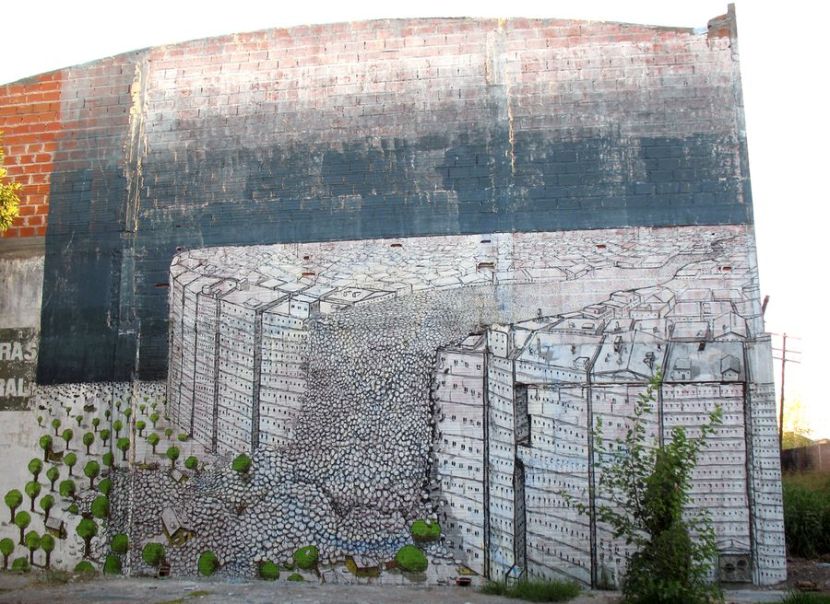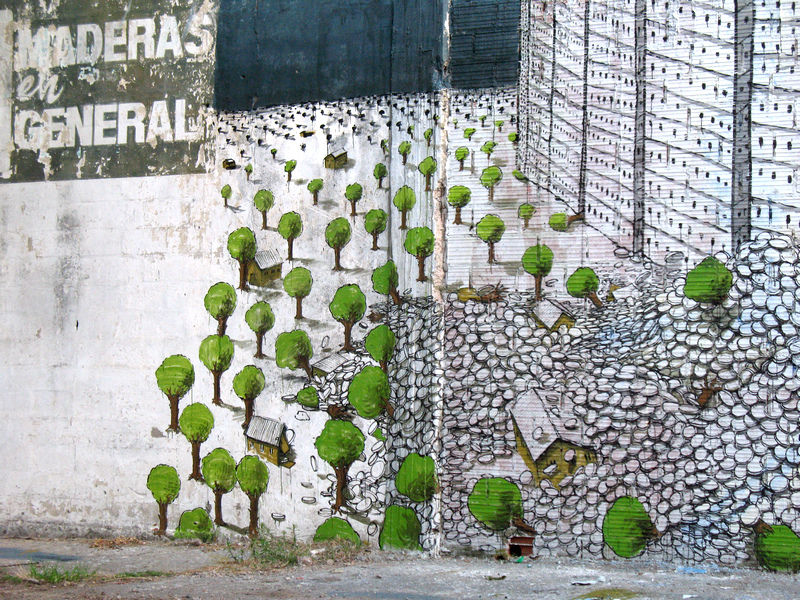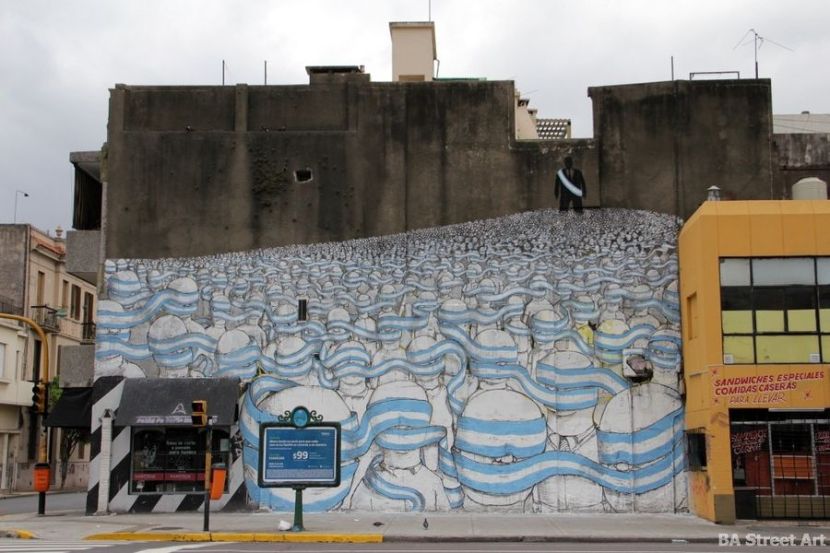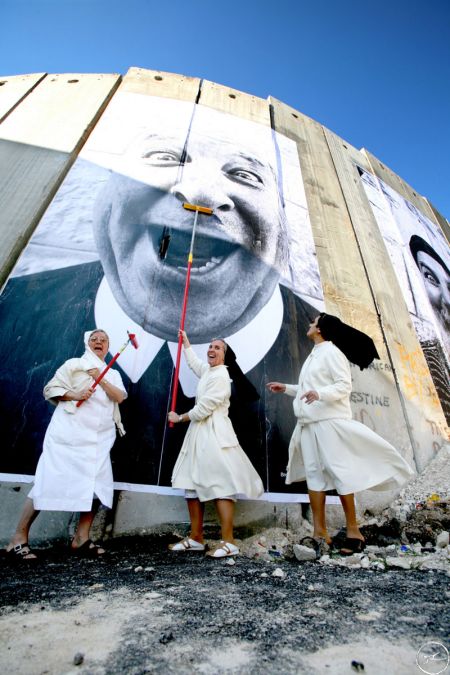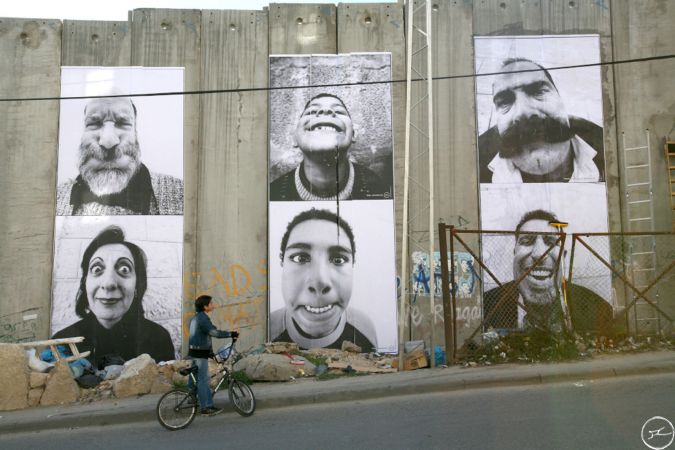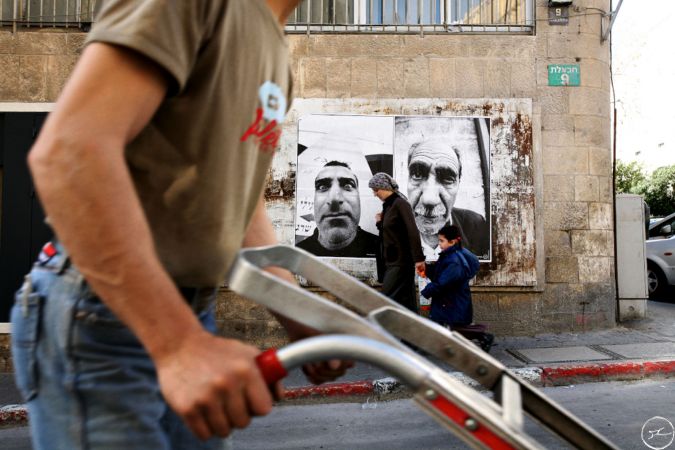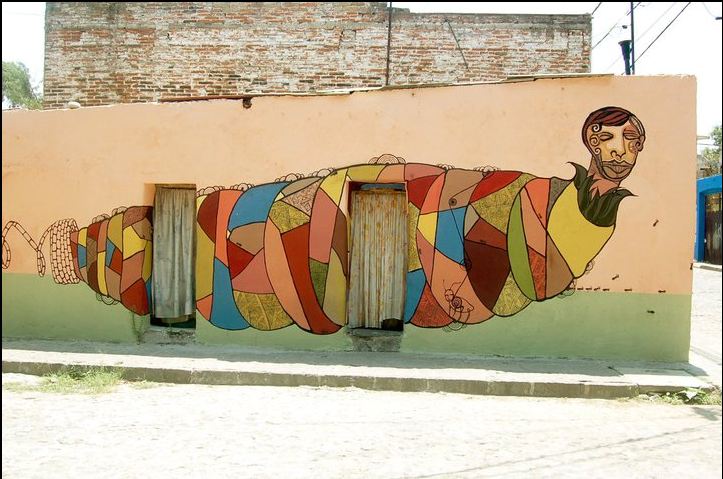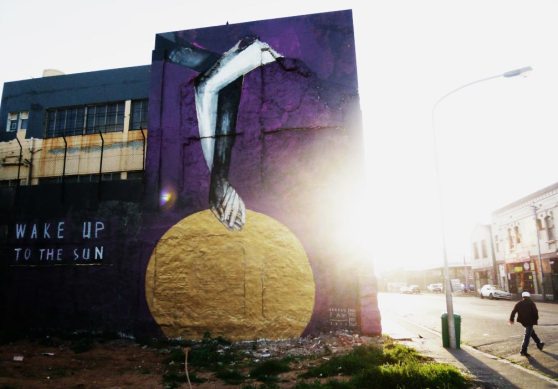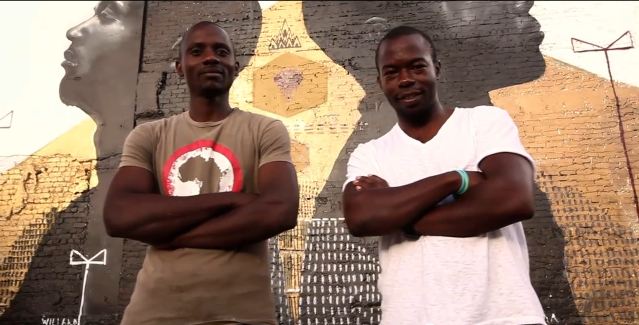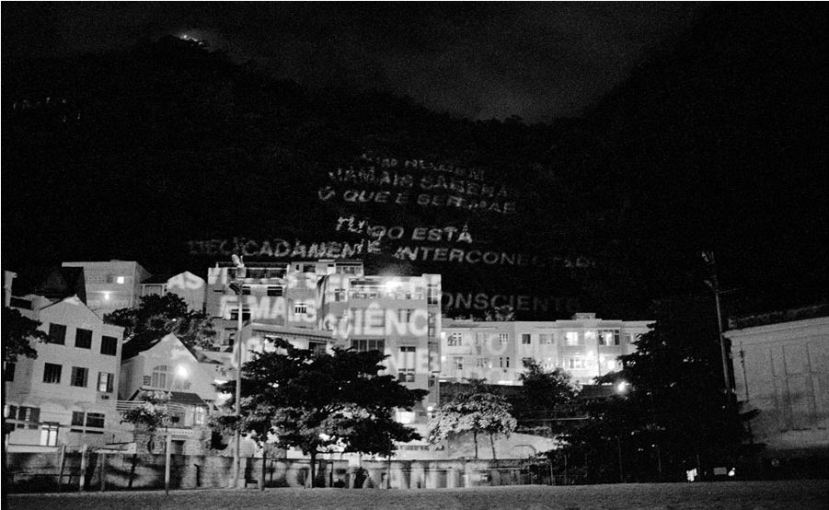Categoria: Street Art
Blu in Buenos Aires
Political message or simple allusion, these walls painted by Blu in Buenos Aires confirm the artist’s talent. The last one painted by the artist shows a flood of coins on the city, despite of the nature. We see on the second wall blindfolded characters wearing the colors of the Argentine flag with in the background a black figure wearing a tie and the presidential sash and who seems to dominate and lead the crowd. The third one seems to be a planet with characters turning around. The fourth wall shows humans ready to be cooked as meat pieces.
Messaggio politico o semplice allusione, i muri dipinti da Blu a Buenos Aires confermano il talento dell’artista. L’ultimo (nella prima foto) rappresenta una marea di monete sulla città che invadono la presenza della natura. Nel secondo muro una folla di individui bendati con una fascia coi colori della bandiera argentina, e sullo sfondo una figura nera con la cravatta e la fascia presidenziale e che sembra dominare e guidare la folla. Il terzo sembra essere un pianeta con caratteri voltarsi. Il quarto mostra degli uomini pronti per essere cucinati come pezzi di carne.
JR puts the people “Face 2 Face”, an Israeli and Palestinian project
In 2007, during the Face 2 Face project, JR and Marco organize the largest illegal photography exhibition ever.
For this project, portraits of Israelis and Palestinians are pasted face to face, in monumental formats on both sides of the wall and in several Palestinian and Israeli cities.
Nel 2007, per Face 2 Face, JR e Marco hanno organizzato la più grande mostra fotografica illegale.
Per questo progetto, ritratti di israeliani e palestinesi sono stati incollati faccia a faccia, in formati monumentali su entrambi i lati del muro e in diverse città palestinesi e israeliane.
from: http://www.jr-art.net
Puebla Ciudad Mural
Puebla Ciudad Mural is being implemented in the Barrio Xanenetla in Puebla, Mexico with the purpose of generating favorable conditions for the residents, dignify their houses facades and promote the expression of muralism as a link tool between artists and residents of the community.
Besides the social and urban improvements, the project is also looking to improve economically the area presenting it as a new touristic attraction in the city.
The Barrio Xanenetla is a needed neighborhood just outside downtown Puebla, and by joining us in this project, you will be helping them to have a better quality of life and to dignified their houses. This project goes beyond the murals. The bonds developed between the international artists, the local artists and the residents of the neighborhood will define the experience.
“Puebla Mural Ciudad” viene attuato nel quartiere di Xanenetla a Puebla in Messico, con lo scopo di generare le condizioni favorevoli per i residenti, nobilitare le facciate delle loro case e favorire l’espressione del muralismo come strumento di collegamento tra artisti e residenti della comunità.
Oltre ai miglioramenti sociali e urbani, il progetto sta anche cercando di migliorare economicamente la zona presentandosi come una nuova attrazione turistica della città.
Xanenetla Barrio è un quartiere bisognoso appena fuori il centro di Puebla; unendoti a noi in questo progetto, permetterai di avere una migliore qualità della vita e dignità nelle case dei suoi abitanti. Questo progetto va oltre le pitture murali; quest’esperienza consiste nei legami sviluppati tra gli artisti internazionali, gli artisti locali e la popolazione del quartiere.
Freddy Sam “removes the greyness from the soul of the city”
This video is for the Artist Network Program supported by RVCA. The mural is of Juma and Willard two guys I work with who are from Zimbabwe.’ A very nice video by Rowan Pybus from Makhulu Productions.
Muro, a street artist in Dakar, Senegal
Jace in Madagascar: wind blows on the sails of art
Jace, street artist, traveled to Madagascar Island and lived with the people of Anakao for two weeks, experimenting with the local fishermen and their sails.
This is a moving experience to live and share the joyful moments of connecting the little character “gouzou” with the generous unhabitant of some of the wildest place in the world.
Jace, street artist, si è recato in Madagascar e ha vissuto con la gente di Anakao per due settimane, sperimentando con i pescatori locali e le loro vele.
E’ stato un momento emozionante per condividere momenti gioiosi e per connettere il suo piccolo personaggio chiamato “gouzou” con il ambiente generoso e florido, uno dei luoghi più incontaminati al mondo.
From: http://www.fatcap.com
Ever, an artist between reality and abstraction
Ever (Nicolás Romero) is a former graffiti writer who began painting in the streets of Buenos Aires in the 1990’s. From the beginning, he was inspired by the street’s potential for projecting concepts and colour into the daily lives of thousands of passers-by.
With his more traditional “painterly” style, Ever often creates works one would expect to see hanging in a gallery instead of adorning a concrete urban wall. This is part of what makes Ever’s work so engaging. The anonymous faces he paints acquire gravitas through being recreated at scale throughout the city, and with his style seldom seen in the context of the street, it becomes all the more powerful for its unexpected presence.
Ever (Nicolás Romero) è un ex writer che ha iniziato a dipingere per le strade di Buenos Aires nel 1990. Fin dall’inizio, è stato ispirato dalle potenzialità della strada per diffondere visioni e colori nella vita quotidiana di migliaia di passanti.
Con il suo tradizionale stile “pittorico”, crea opere che ci si aspetterebbe di vedere appese in una galleria, invece che su un muro di cemento. Questo è parte di ciò che rende il suo lavoro così coinvolgente. Dipinge visi anonimi e non, che acquisiscono quasi un carattere di solennità in quanto sono riprodotti in grande scala per tutta la città e, con il suo stile originale per il contesto della strada, diventa tanto più potente per la sua presenza inaspettata.
From: http://graffitimundo.com
Homeland, start living off the grid
In short, Homeland is a cross country Wet-Plate Collodion photo-essay documenting the grassroots efforts to rebuild life after the collapse of the American economy.
Cities such as New Orleans, Detroit, Pittsburgh and NYC will be documented, as well as many smaller towns and rural areas in between. The range of projects documented will include urban farms, bicycle collectives, off-the grid homes, alternative fuel producers, art and theatre collectives, community dinners, free schools and after-school programs, squats, itinerants, tent cities and many other grassroots social practices.
Read more: http://www.kickstarter.com/projects/1222154967/homeland-a-wet-plate-collodion-photo-essay
In breve, Homeland è un progetto itinerante fotografico al collodio umido che documenta gli sforzi delle persone per ricostruire la vita dopo il crollo dell’economia americana.
Verranno documentate città come New Orleans, Detroit, Pittsburgh e New York, così come molti paesi più piccoli e aree rurali dell’entroterra. La gamma di progetti documentati comprenderà fattorie urbane, collettivi di biciclette, tipologie di vita fuori dal sistema, produttori di carburanti alternativi, arte e collettivi teatrali, cene sociali, scuole gratuite e programmi di dopo-scuola, squat, nomadi, tendopoli e molte altre pratiche sociali popolari.
Per saperne di più: http://www.kickstarter.com/projects/1222154967/homeland-a-wet-plate-collodion-photo-essay
Jenny Holzer in Buenos Aires and Rio de Janeiro
Buenos Aires
Rio de Janeiro
Jenny Holzer wants to maintain a separation between her and the public, depersonalizing her writings, communicates with a neutral voice and treats general topics. She was influenced by conceptual art and the feminist movement, both of the 60s and 70s, which reflected about the question of the author.
Holzer puts her messages in public places quietly and realistically, even because of the use of descreet media, so that you realize casually their strong presence. Then the observer can establish a relationship of dependency and the more he is involved in the work, the more the media effects can influence him.
Jenny Holzer vuole mantenere un distacco tra lei e il pubblico e per questo spersonalizza i suoi scritti, comunica con una voce neutra e tratta di argomenti generali. In questo fu influenzata dal movimento femminista e dall’Arte Concettuale, entrambi degli anni ‘60-‘70, i quali riflettevano sulla questione dell’autore.
La Holzer inserisce silenziosamente e in modo realistico i suoi messaggi nei luoghi pubblici, anche grazie all’utilizzo di media poco appariscenti, così che ci si accorge casualmente, passando, della loro forte presenza. Ne consegue che l’osservatore può instaurare un legame di dipendenza e più viene coinvolto dall’opera, maggiori sono gli effetti mediali che possono influenzarlo.
Paint Attack Sao Paulo
Painting Reality in Brazil
As a part of the Baixo Centro Festival which took place in Brazil’s biggest metropolis, a group of activists tipped out several buckets of colorful paint on a much used junction and started in that way the great process of an urban live painting, using cars, bikes and pedestrians as brushes, spreading the paint all over the streets! Again it’s just amazing to see how easily you can color your city and have a lot of fun.
Pitturare la realtà in Brasile
All’interno del Festival Baixo Centro che ha avuto luogo nella più grande metropoli del Brasile, un gruppo di attivisti ha ribaltato diversi secchi di vernice colorata su un incrocio molto trafficato e ha iniziato in questo modo il grande processo di creazione di un quadro urbano vivo, con auto, moto e pedoni che, come pennelli, hanno steso la pittura per tutte le strade! Anche in questo caso è semplicemente incredibile vedere con quanta facilità è possibile dare colore alla propria città e divertirsi un sacco.
